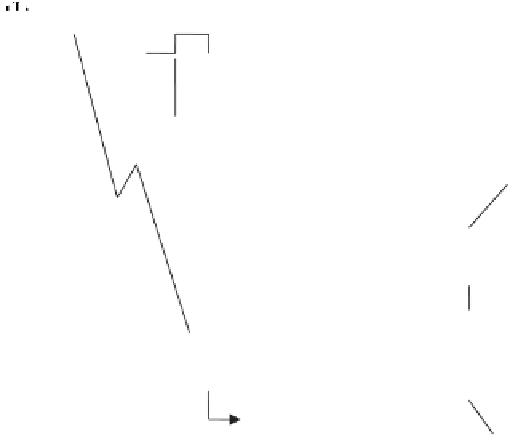Global Positioning System Reference
In-Depth Information
The most important concept presented in this section is the measurement rela-
tionship between the replica code phase state in the GPS receiver and the satellite
transmit time. This relationship is unambiguous for P(Y) code, but can be ambigu-
ous for C/A code. Every C/A code GPS receiver is vulnerable to this ambiguity prob-
lem and, under weak signal acquisition conditions, the ambiguity will occur. When
the ambiguity does occur in a C/A code GPS receiver, it causes serious range mea-
surement errors, which, in turn, result in severe navigation position errors.
5.7.1 Pseudorange
The definition of pseudorange to
SV
i
, where
i
is the PRN number is as follows:
[
]
()
()
()
()
ρ
i
ncTnTn
=
−
m
(5.27)
R
Ti
where:
c
=
speed of light
=
299,792,458 (m/s)
T
R
(
n
)
receive time corresponding to epoch
n
of the GPS receiver's clock
(seconds)
T
Ti
(
n
)
=
=
transmit time based on the
SV
i
clock (seconds)
Figure 5.29 depicts the GPS satellite
SV
i
transmitting its PRN code
PRN
i
start-
ing at the end of the GPS week. Corresponding to each chip of the
PRN
i
code is a lin-
ear
SV
i
clock time. When this signal reaches the GPS receiver, the transmit time,
T
Ti
(
n
), is the
SV
i
time corresponding to the PRN code state that is being replicated at
receiver epoch
n
. The pseudorange derived from this measurement corresponds to a
SV
i
PRN code at transmit time
i
φ
1
φ
2
φ
k
φ
k+1
SV clock at transmit time
i
T
1
T
2
T
k
T
k+1
End of week
Transmit time (n) = T
(n)
Ti
Replica PRN code
at receive time
i
φ
1
φ
(n)
φ
2
φ
k
φ
k+1
Code
accumulator at
receive time
T
1
T
(n)
T
2
T
k
T
k+1
Receiver FTF
FTF
(n)
GPS receiver
Pseudorange measurement (n)@T(n)
R
Figure 5.29
Relationship of satellite transmit time to pseudorange measurements.






















Search WWH ::

Custom Search